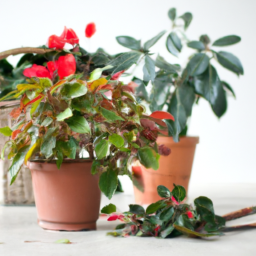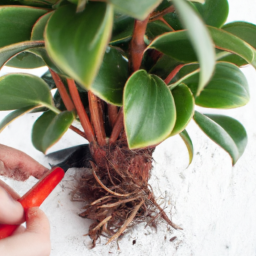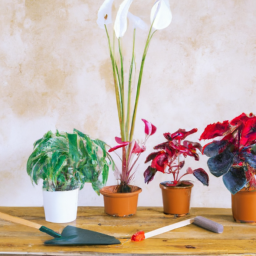
Winter Plant Care: Nurturing Through the Cold
As the temperature drops and the days grow shorter, it’s time to shift our attention to the well-being of our beloved plants. Winter can be a challenging season for our leafy companions, but with a little extra care and attention, we can ensure they thrive even in the coldest of months. In this blog post, we will delve into the art of winter plant care and explore the various ways we can nurture our green friends through the cold. From protecting them from frost to providing adequate moisture, we’ll cover all the essential tips and tricks to keep your plants healthy and happy throughout the winter season. So grab a warm cup of tea, cozy up by the fire, and let’s embark on this journey of winter plant care together.
Winter Plant Protection: Shielding Your Plants from Frost and Cold Temperatures
Winter can be a challenging time for plants, with freezing temperatures and frost posing a threat to their survival. However, with proper care and attention, you can ensure that your plants thrive even in the coldest months. In this guide, we will provide you with step-by-step instructions on how to protect your plants from frost and cold temperatures, allowing them to flourish throughout the winter season.
Understanding Frost and Its Impact on Plants
Frost occurs when the temperature drops below freezing point, causing water vapor in the air to condense into ice crystals. These ice crystals can damage plant cells, leading to wilting, browning, and even death. It’s crucial to understand the impact of frost on plants to effectively protect them.
During frosty nights, plants lose moisture through the process of transpiration. As the temperature drops, the rate of transpiration decreases, causing water to freeze within the plant tissues. This freezing process disrupts the cell structure and can result in irreversible damage.
Now that we have a basic understanding of frost and its effects on plants, let’s explore the steps you can take to shield your plants from the cold temperatures:
1. Select Cold-Hardy Plants
Before winter arrives, it’s essential to choose plants that are well-suited for colder climates. Cold-hardy plants have a natural ability to withstand freezing temperatures and are less likely to suffer from frost damage. Research and select plant varieties that are known to thrive in your specific region during winter.
Some popular cold-hardy plants include conifers, such as pine and spruce trees, as well as evergreen shrubs like boxwood and holly. These plants have adapted to survive harsh winter conditions and can serve as a foundation for your winter garden.
2. Provide Adequate Insulation
Insulating your plants is crucial for protecting them from frost and cold temperatures. One effective method is using mulch to create a protective layer around the base of the plants. Apply a thick layer of organic mulch, such as straw or wood chips, to help regulate soil temperature and retain moisture.
Additionally, consider using frost blankets or row covers to shield vulnerable plants. These lightweight fabrics allow sunlight, air, and water to reach the plants while providing insulation against freezing temperatures. Secure the covers tightly to prevent any gaps that may allow cold air to seep in.
3. Watering and Hydration
Proper watering is essential for winter plant care. While it may seem counterintuitive, it’s crucial to ensure that your plants receive adequate hydration during the winter months. Watering the plants a day or two before an expected frost can help protect them by increasing the moisture content in their cells.
Be cautious not to overwater, as excessive moisture can lead to root rot. Water the plants early in the day, allowing sufficient time for the foliage to dry before temperatures drop at night. This helps prevent the formation of ice crystals on the leaves, reducing the risk of frost damage.
4. Shielding Plants from Cold Winds
Cold winds can exacerbate the effects of frost on plants. Creating a windbreak can significantly reduce the impact of cold winds and protect your plants. Planting a dense hedge or erecting a temporary barrier made of burlap or plastic sheeting can effectively shield your plants from chilly gusts.
Position the windbreak on the side of the prevailing wind to create a barrier that diverts the cold air away from your plants. This simple step can make a significant difference in preventing winter damage.
5. Monitor and Prune
Regular monitoring of your plants during winter is essential to identify any signs of frost damage or other issues promptly. Inspect the foliage, stems, and branches for discoloration, wilting, or other abnormalities. If you notice any damaged parts, prune them immediately to prevent further spread of the damage.
When pruning, make clean cuts just above a bud or branch junction. This promotes healthy regrowth once the warmer months arrive. Dispose of the pruned material properly, as it may harbor pests or diseases that could harm your plants.
By following these steps, you can effectively protect your plants from frost and cold temperatures, ensuring their health and vitality throughout the winter season. Remember, each plant has unique requirements, so it’s essential to research specific care instructions for the plants in your garden. With proper winter plant care, you can enjoy a thriving garden all year round!

Essential Winter Plant Care Tips: Watering, Pruning, and Insulating for Optimal Growth
Winter can be a challenging time for plants, as the cold temperatures and harsh weather conditions can take a toll on their health. However, with proper care and attention, you can ensure that your plants not only survive but thrive during the winter months. In this guide, we will discuss essential winter plant care tips including watering, pruning, and insulating techniques to help your plants maintain optimal growth and health.
Watering
Proper watering is crucial for winter plant care. While it may seem counterintuitive, plants still need water during the colder months. However, the watering requirements may differ compared to other seasons. Here are some key tips to keep in mind:
1. Monitor Soil Moisture: Check the moisture level of the soil regularly. Winter conditions can vary, and the soil may dry out faster or retain more moisture depending on factors such as temperature and precipitation. Stick your finger into the soil to a depth of about an inch and if it feels dry, it’s time to water.
2. Watering Frequency: In general, plants require less water during winter compared to warmer months. Reduce the frequency of watering, but make sure to provide deep watering when needed. Watering deeply encourages plants to develop strong root systems, which helps them withstand the cold and absorb nutrients efficiently.
3. Time Your Watering: Water your plants during the early part of the day to allow excess moisture to evaporate before nighttime. This helps prevent the growth of fungi and reduces the risk of diseases that thrive in damp conditions.
Pruning
Pruning is an essential winter plant care practice that promotes healthy growth and maintains the shape of your plants. Here are some pruning tips for the winter season:
1. Remove Dead or Diseased Branches: Inspect your plants for any dead or diseased branches and promptly remove them. These branches can attract pests and diseases, which can spread to healthy parts of the plant. Pruning also allows better air circulation and sunlight penetration, which is crucial during the winter months.
2. Shape and Size Control: Winter is an ideal time to shape and control the size of your plants. Trim back any overgrown branches or stems to maintain a compact and tidy appearance. However, be cautious not to over-prune, as it can stress the plant and hinder its growth.
3. Prune After Frost: If you live in an area with frost, it’s best to wait until after the last frost to prune your plants. Pruning before frost can stimulate new growth, which may be susceptible to damage from freezing temperatures.
Insulating
Insulating your plants during winter helps protect them from extreme cold and frost damage. Here are some effective insulation techniques:
1. Mulching: Apply a layer of organic mulch around the base of your plants. Mulch acts as insulation, helping to regulate soil temperature and retain moisture. It also prevents weed growth and reduces the risk of soil erosion.
2. Covering: For more delicate plants or those in containers, consider covering them with frost blankets or burlap. These covers provide an extra layer of protection against freezing temperatures and harsh winds.
3. Grouping Plants: Cluster potted plants together to create a microclimate. The plants will benefit from the collective warmth they generate, providing protection against extreme cold.
By following these essential winter plant care tips, you can ensure that your plants not only survive but thrive during the cold months. Remember to monitor soil moisture, adjust watering frequency, prune strategically, and provide adequate insulation. With proper care, your plants will emerge from winter stronger and ready to flourish in the coming spring.

Indoor Plant Care During Winter: Creating the Ideal Environment for Healthy Winter Growth
Winter can be a challenging time for indoor plants. The cold temperatures, dry air, and reduced sunlight can all take a toll on their health. However, with proper care and attention, you can create an ideal environment for your plants to thrive even during the coldest months of the year. In this article, we will provide you with a step-by-step guide on how to nurture your indoor plants through the winter.
1. Adjusting Light Exposure
During winter, the amount of natural light available to your indoor plants decreases significantly. Therefore, it is crucial to adjust their light exposure to ensure they receive enough light for healthy growth. Here are a few tips:
Positioning: Place your plants near south-facing windows where they can receive the maximum amount of sunlight. If you don’t have south-facing windows, consider using artificial grow lights to supplement the light requirements of your plants.
Rotate: Rotate your plants regularly to ensure all sides receive equal exposure to light. This will prevent them from leaning towards the light source and promote even growth.
Duration: Most indoor plants require around 12-14 hours of light per day. Use a timer to ensure they receive consistent light exposure, especially during the shorter winter days.
2. Regulating Temperature and Humidity
The winter season often brings dry air and fluctuating temperatures, which can negatively impact your indoor plants. Maintaining the right temperature and humidity levels is crucial for their overall health. Here’s how you can regulate these factors:
Temperature: Most indoor plants prefer temperatures between 60-75°F (15-24°C). Avoid placing them near drafty windows or heating vents, as sudden temperature fluctuations can stress the plants. Use a thermometer to monitor the temperature and make necessary adjustments.
Humidity: Dry indoor air can be a challenge for plants during winter. Increase humidity levels by placing a tray filled with water near your plants or using a humidifier. Grouping plants together can also create a microclimate with higher humidity.
Misting: Misting the leaves of your plants with water can help increase humidity levels temporarily. However, avoid misting plants with hairy leaves, as it can lead to fungal diseases.
3. Adjusting Watering and Fertilizing
Watering and fertilizing requirements of indoor plants change during winter due to reduced growth rates and lower light levels. It is essential to adapt your watering and fertilizing routine accordingly. Here are some guidelines:
Watering: Check the moisture level of the soil before watering. Stick your finger about an inch deep into the soil – if it feels dry, it’s time to water. Be careful not to overwater, as this can lead to root rot. Water thoroughly but allow the excess water to drain out completely.
Fertilizing: Most indoor plants enter a period of dormancy during winter, requiring less fertilizer. Reduce the frequency of fertilization to once every 6-8 weeks, or as indicated by the plant’s specific needs. Use a balanced, water-soluble fertilizer and dilute it to half the recommended strength.
Monitoring: Keep a close eye on your plants for any signs of overwatering or underwatering. Adjust your watering schedule accordingly and consider using a moisture meter to accurately determine the moisture level in the soil.
By following these steps and providing the necessary care, you can ensure that your indoor plants stay healthy and thriving throughout the winter season. Remember to observe your plants closely and make adjustments as needed. With a little extra attention, your indoor garden can bring joy and beauty even during the coldest months of the year.
Key Takeaways
Winter can be a challenging time for plants, as the cold weather and harsh conditions can take a toll on their health. However, with a little extra care and attention, you can ensure that your plants survive and thrive through the winter months. One important aspect of winter plant care is providing adequate protection. This can be done by mulching around the base of the plants to insulate the roots and prevent them from freezing. Additionally, covering delicate plants with burlap or frost cloth can shield them from extreme temperatures and drying winds. It’s also essential to water your plants properly during winter. While it may seem counterintuitive, plants still need water even when it’s cold outside. However, it’s crucial to water them sparingly and only when the soil is dry. Overwatering can lead to root rot, so it’s best to check the moisture levels before watering. Lastly, it’s important to monitor your plants for signs of stress or damage. If you notice any yellowing leaves, wilting, or discoloration, it’s crucial to take action promptly. Pruning damaged or dead branches and providing extra support for weak stems can help your plants stay healthy and strong throughout the winter season. By following these tips and giving your plants the care they need, you can ensure they survive the cold and emerge vibrant and beautiful come springtime.
Top FAQs:
Q1: What are some important tips for winter plant care?
A1: When it comes to winter plant care, there are a few key tips to keep in mind. First, it’s important to provide adequate insulation for your plants. This can be done by mulching around the base of the plants to protect their roots from freezing temperatures. Additionally, you should avoid overwatering your plants during winter, as this can lead to root rot. It’s also crucial to monitor the moisture levels of your plants’ soil and water them only when necessary. Lastly, consider bringing sensitive plants indoors or providing them with extra protection, such as covering them with frost blankets, to shield them from harsh winter conditions.
Q2: How often should I water my plants during winter?
A2: The frequency of watering your plants during winter largely depends on the specific needs of each plant and the climate you live in. Generally, plants require less water during winter due to lower evaporation rates and slower growth. It’s essential to monitor the moisture levels of the soil by checking it regularly. If the soil feels dry to the touch, it’s time to water your plants. However, be cautious not to overwater them, as this can lead to root rot. Adjust your watering schedule accordingly based on the individual needs of your plants.
Q3: Can I fertilize my plants during winter?
A3: In general, it’s best to avoid fertilizing your plants during winter. Most plants enter a dormant period during this time, where their growth slows down significantly. Fertilizing can stimulate new growth, which may be more susceptible to damage from freezing temperatures. It’s advisable to wait until spring when the plants start actively growing again before resuming fertilization. However, if you have specific plants that require winter fertilization, it’s essential to research their specific needs and consult with a gardening expert.
Q4: How can I protect my plants from frost and cold temperatures?
A4: To protect your plants from frost and cold temperatures, there are a few measures you can take. First, consider covering your plants with frost blankets or burlap to provide insulation. This helps trap heat and prevents frost from settling on the plants. You can also create a makeshift greenhouse effect by using plastic covers or cloches. Another option is to move potted plants indoors or to a sheltered area, such as a garage or porch, during extreme cold spells. Finally, grouping plants together can create a microclimate that offers additional protection against the cold.
Q5: Are there any specific plants that require extra care during winter?
A5: Yes, certain plants are more sensitive to cold temperatures and require extra care during winter. Tender plants like tropical varieties, succulents, and citrus trees are particularly vulnerable to frost and freezing temperatures. These plants should be brought indoors or provided with extra protection, such as covering them with frost blankets or moving them to a sheltered area. It’s important to research the specific needs of your plants to ensure they receive the necessary care during winter.

James Wong is a renowned ethnobotanist, plant scientist, and local television presenter. With a passion for demystifying plant science, he is known for translating complex botanical concepts into practical advice for everyday plant enthusiasts. James’s expertise spans from traditional gardening to cutting-edge plant technologies, making his insights accessible and informative.


